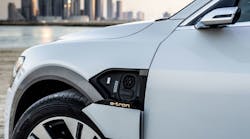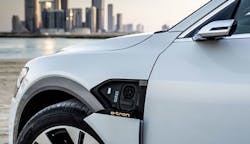The advantages of sustainable, cost-efficient energy are considerable, but with them come significant challenges. Eventually, peak energy demands of vehicles and buildings will need to adapt to the capacity and the limitations of the electrical grid.
The Audi e-tron is the first EV whose charging system uses the new EEBUS communication standard for energy communications. EEBUS, developed by a 70-member consortium, aims to connect electrical vehicles with smart-home systems, photovoltaic suppliers, energy managers, and other stakeholders with regard to energy management and usability.
At an event dubbed “Plugfest E-Mobility” at the Audi plant in Brussels, Belgium, developers tested cross-industry compatibility using the EEBUS standard. Engineers performed model tests to check whether the photovoltaics system, the charging infrastructure, the electric car, and the heating system could communicate without interference.
The devices were connected via what’s known as a home energy management system (HEMS). All of the information ran together in this control center, which allowed all energy-relevant devices to successfully exchange information on their electricity requirements.
In the future, the electric car will play an important role in the digital energy world as a power consumer. Experts believe that it also has great potential as a power storage device to cushion peak loads. Because cars may be parked most of the day—for example, in the parking area at work—this offers plenty of time for flexible charging. As a result, the new electricity consumers not only wouldn’t place an additional burden on the power grid, but they could use their vehicles as potentially flexible storage facilities to fill in when needed, since solar and wind power come with variable availability.
Within a building, electric cars also could coordinate the respective energy requirements with household appliances, heat pumps, and other power consumers, thus avoiding overloads. To do all of this, however, requires the networking of all major producers and consumers in order to intelligently control electricity demand. This is exactly what the EEBUS initiative has set out to do: seamless and cross-sector communication in the energy system of the future. Presently, over 70 international companies are working on the common EEBUS language for energy management on the Internet of Things.
Proponents of EEBUS point out that an interface with the grid operator via HEMS is just one possible application. Communications would allow electric cars to better adapt their planning during periods of grid bottlenecks and ensure that the power grid is stable when multiple electric cars are simultaneously charging on the same road.
The Audi System
Audi offers various solutions for charging at home. The automaker’s optional connect charging system allows for a charging capacity of up to 22 kW. It then takes only around four and a half hours to fully charge the Audi e-tron.
At the Audi plant in Brussels, developers tested the cross-industry communications compatibility of the Audi e-tron electric SUV.
The benefits of the system are obvious. With the connect charging system, the Audi e-tron can always be charged with the maximum output possible as the system also considers the power requirements of other consumers in the household. It will adjust accordingly to prevent overloading the home electrical system and thus tripping the circuit breaker. This presumes that the home is equipped with a compatible HEMS to which the charging system connects via the home’s Wi-Fi network. In this context, Audi is cooperating with two partner companies, SMA Solar Technology and Hager Group, both of which are also implementing the EEBUS initiative’s standard.
In combination with the connect charging system and an appropriately equipped HEMS, the Audi e-tron can take advantage of variable electricity rates. It’s able to charge the battery when electricity is less expensive while simultaneously considering the customer’s mobility requirements, such as departure time and charge level. The connect charging system gets the necessary rate information either from HEMS or from information entered into the myAudi portal by the customer.
If the home is equipped with a photovoltaic system, the customer can also optimize the charging process to choose the electricity generated by the solar-based system for charging the Audi e-tron. The electric SUV does this by considering either forecast phases of sunshine or the current flow of electricity at the home’s connection point to the public grid.
In a separate but related announcement, Microsoft has joined the EEBUS Initiative and is working with KEO GmbH to ensure availability of the EEBUS standard on Azure Sphere cloud-enabled devices. Microsoft Azure Sphere is an end-to-end solution for creating secure, connected Microcontroller (MCU) devices. EEBUS-compatible software from KEO GmbH on Azure Sphere will provide a universal and trusted basis for communication between networked energy managers, EV charging stations, battery-storage locations, and many other energy-related users and providers to securely deliver the promise of a truly “smart” grid.


